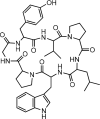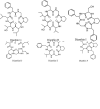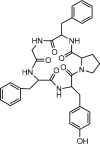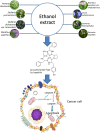Cancer Treatment by Caryophyllaceae-Type Cyclopeptides
- PMID: 33519710
- PMCID: PMC7841296
- DOI: 10.3389/fendo.2020.600856
Cancer Treatment by Caryophyllaceae-Type Cyclopeptides
Abstract
Cancer is one of the leading diseases, which, in the most cases, ends with death and, thus, continues to be a major concern in human beings worldwide. The conventional anticancer agents used in the clinic often face resistance among many cancer diseases. Moreover, heavy financial costs preclude patients from continuing treatment. Bioactive peptides, active in several diverse areas against man's health problems, such as infection, pain, hypertension, and so on, show the potential to be effective in cancer treatment and may offer promise as better candidates for combating cancer. Cyclopeptides, of natural or synthetic origin, have several advantages over other drug molecules with low toxicity and low immunogenicity, and they are easily amenable to several changes in their sequences. Given their many demanded homologues, they have created new hope of discovering better compounds with desired properties in the field of challenging cancer diseases. Caryophyllaceae-type cyclopeptides show several biological activities, including cancer cytotoxicity. These cyclopeptides have been discovered in several plant families but mainly are from the Caryophyllaceae family. In this review, a summary of biological activities found for these cyclopeptides is given; the focus is on the anticancer findings of these peptides. Among these cyclopeptides, information about Dianthins (including Longicalycinin A), isolated from different species of Caryophyllaceae, as well as their synthetic analogues is detailed. Finally, by comparing their structures and cytotoxic activities, finding the common figures of these kinds of cyclopeptides as well as their possible future place in the clinic for cancer treatment is put forward.
Keywords: Caryophyllaceae-type cyclopeptides; anticancer activity; dianthins; longicalycinin A; plant family; synthetic analogues.
Copyright © 2021 Houshdar Tehrani, Gholibeikian, Bamoniri and Mirjalili.
Conflict of interest statement
The authors declare that the research was conducted in the absence of any commercial or financial relationships that could be construed as a potential conflict of interest.
Figures


















Similar articles
-
Natural Cyclopeptides as Anticancer Agents in the Last 20 Years.Int J Mol Sci. 2021 Apr 12;22(8):3973. doi: 10.3390/ijms22083973. Int J Mol Sci. 2021. PMID: 33921480 Free PMC article. Review.
-
Structure-activity relationship studies of Longicalcynin A analogues, as anticancer cyclopeptides.Chem Biol Interact. 2020 Jan 5;315:108902. doi: 10.1016/j.cbi.2019.108902. Epub 2019 Nov 17. Chem Biol Interact. 2020. PMID: 31747558
-
Two new minor cyclopeptides from Sagina japonica (Caryophyllaceae).Fitoterapia. 2009 Apr;80(3):192-5. doi: 10.1016/j.fitote.2009.01.004. Epub 2009 Jan 23. Fitoterapia. 2009. PMID: 19535020
-
Cyclopeptides from Sagina japonica (Caryophyllaceae).Chem Biodivers. 2007 Feb;4(2):241-7. doi: 10.1002/cbdv.200790029. Chem Biodivers. 2007. PMID: 17311235
-
[Progress in the study of some important natural bioactive cyclopeptides].Yao Xue Xue Bao. 2012 Mar;47(3):271-9. Yao Xue Xue Bao. 2012. PMID: 22645749 Review. Chinese.
Cited by
-
Anticancer Ribosomally Synthesized and Post-Translationally Modified Peptides from Plants: Structures, Therapeutic Potential, and Future Directions.Curr Issues Mol Biol. 2024 Dec 26;47(1):6. doi: 10.3390/cimb47010006. Curr Issues Mol Biol. 2024. PMID: 39852121 Free PMC article. Review.
-
Lipid oxidation in pathophysiology of atherosclerosis: Current understanding and therapeutic strategies.Int J Cardiol Cardiovasc Risk Prev. 2022 Aug 4;14:200143. doi: 10.1016/j.ijcrp.2022.200143. eCollection 2022 Sep. Int J Cardiol Cardiovasc Risk Prev. 2022. PMID: 36060286 Free PMC article. Review.
-
Identification of a key peptide cyclase for novel cyclic peptide discovery in Pseudostellaria heterophylla.Plant Commun. 2025 May 12;6(5):101315. doi: 10.1016/j.xplc.2025.101315. Epub 2025 Mar 13. Plant Commun. 2025. PMID: 40083160 Free PMC article.
-
Identification and functional analysis of novel precursor genes in cyclic peptide biosynthesis in Pseudostellaria heterophylla.BMC Plant Biol. 2025 Aug 20;25(1):1103. doi: 10.1186/s12870-025-06972-2. BMC Plant Biol. 2025. PMID: 40836224 Free PMC article.
-
Dianthiamides A-E, Proline-Containing Orbitides from Dianthus chinensis.Molecules. 2021 Nov 30;26(23):7275. doi: 10.3390/molecules26237275. Molecules. 2021. PMID: 34885850 Free PMC article.
References
-
- Gopinadh G. Cancer characteristics and its causes. Res Rev J Med Health Sci (2015) 4:1.
-
- Cancer Tomorrow - IARC . 150 Cours Albert Thomas, 69372 Lyon CEDEX 08, France.
Publication types
MeSH terms
Substances
LinkOut - more resources
Full Text Sources
Other Literature Sources
Medical

